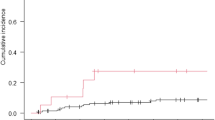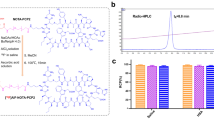Abstract
Objective
[18F]Fluciclovine (anti-[18F]FACBC) has demonstrated diagnostic efficacy for cancers of the brain where [18F]fludeoxyglucose has limitations. We conducted a phase IIa study of anti-[18F]FACBC to assess its accumulation pattern and safety in patients with malignant glioma.
Methods
Five patients with glioma scheduled for brain tumor resection received anti-[18F]FACBC. Brain positron emission tomography (PET) was performed following intravenous administration of anti-[18F]FACBC, and subsequently, preoperative gadolinium contrast-enhanced T1-weighted (CE-T1W) magnetic resonance imaging (MRI) was performed for surgery. Specimens for histopathological evaluation were collected during surgery, and their location was precisely determined on CE-T1W MRI and anti-[18F]FACBC PET/CT images. In addition, tumor extent defined on the MRI and PET/CT images was compared. To determine time–activity curves for anti-[18F]FACBC uptake in brain tumor and normal tissues, regions of interest were set in the brain tumor, contralateral normal tissue and the cerebellum, and their standardized uptake values (SUV) were calculated. The safety of anti-[18F]FACBC was assessed based on subjective symptoms and objective findings, electrocardiograms, vital signs, laboratory results, and the incidence of adverse events.
Results
Anti-[18F]FACBC accumulated in the malignant gliomas of all patients. CE-T1W MRI detected gliomas in all patients, but anti-[18F]FACBC PET/CT generally delineated wider regions of tumor extent than CE-T1W MRI. Two of the histopathologically confirmed tumors were located in regions that were defined using anti-[18F]FACBC PET/CT, but not using CE-T1W MRI. Two patients experienced three mild adverse events: one complained of a dull headache and later a mild headache, and the other showed general malaise. These symptoms resolved spontaneously without treatment. Only the mild headache could not be ruled out from having a causal relationship with anti-[18F]FACBC. Favorable T/N ratios regarding anti-[18F]FACBC uptake between tumors and normal control tissues were demonstrated in this trial.
Conclusions
It is suggested that anti-[18F]FACBC PET/CT has the ability to delineate glioma spread that is undetectable using CE-T1W MRI. Anti-[18F]FACBC is safe in patients with malignant glioma.
This study was registered in the Japan Pharmaceutical Information Center Clinical Trials Information, which is one of the World Health Organization registries (registration number: JapicCTI-111387).



Similar content being viewed by others
References
Stupp R, Mason WP, van den Bent MJ, Weller M, Fisher B, Taphoorn MJ, et al; European Organisation for Research and Treatment of Cancer Brain Tumor and Radiotherapy Groups; National Cancer Institute of Canada Clinical Trials Group. Radiotherapy plus concomitant and adjuvant temozolomide for glioblastoma. N Engl J Med. 2005;352:987–96.
[No authors listed] Report of brain tumor registry of Japan (2001–2004). Neuro Med Chir (Tokyo). 2014; 54 Suppl:1–102.
Stupp R, Brada M, van den Bent MJ, Tonn JC, Pentheroudakis G. ESMO Guidelines Working Group. High-grade glioma: ESMO Clinical Practice Guidelines for diagnosis, treatment and follow-up. Ann Oncol. 2014; 25(Suppl 3):iii93–101.
Soffietti R, Baumert BG, Bello L, von Deimling A, Duffau H, Frénay M, et al; European Federation of Neurological Societies. Guidelines on management of low-grade gliomas: report of an EFNS-EANO Task Force. Eur J Neurol. 2010;17:1124–33.
Schucht P, Beck J, Seidel K, Raabe A. Extending resection and preserving function: modern concepts of glioma surgery. Swiss Med Wkly. 2015;145:w14082.
Dolecek TA, Propp JM, Stroup NE, Kruchko C. CBTRUS statistical report: primary brain and central nervous system tumors diagnosed in the United States in 2005–2009. Neuro Oncol. 2012;14(Suppl 5):v1–49.
Stummer W, Novotny A, Stepp H, Goetz C, Bise K, Reulen HJ. Fluorescence-guided resection of glioblastoma multiforme by using 5-aminolevulinic acid-induced porphyrins: a prospective study in 52 consecutive patients. J Neurosurg. 2000;93:1003–13.
Duffau H, Lopes M, Arthuis F, Bitar A, Sichez JP, Van Effenterre R, et al. Contribution of intraoperative electrical stimulations in surgery of low grade gliomas: a comparative study between two series without (1985–96) and with (1996–2003) functional mapping in the same institution. J Neurol Neurosurg Psychiatry. 2005;76:845–51.
Miwa K, Shinoda J, Yano H, Okumura A, Iwama T, Nakashima T, et al. Discrepancy between lesion distributions on methionine PET and MR images in patients with glioblastoma multiforme: insight from a PET and MR fusion image study. J Neurol Neurosurg Psychiatry. 2004;75:1457–62.
Pauleit D, Floeth F, Hamacher K, Riemenschneider MJ, Reifenberger G, Müller HW, et al. O-(2-[18F]fluoroethyl)-l-tyrosine PET combined with MRI improves the diagnostic assessment of cerebral gliomas. Brain. 2005;128:678–87.
Stummer W, Pichlmeier U, Meinel T, Wiestler OD, Zanella F. Reulen HJ; ALA-Glioma Study Group. Fluorescence-guided surgery with 5–aminolevulinic acid for resection of malignant glioma: a randomised controlled multicenter phase III trial. Lancet Oncol. 2006;7:392–401.
Chierichetti F, Pizzolato G. 18F-FDG-PET/CT. Q J Nucl Med Mol Imaging. 2012;56:138–50.
Galldiks N, Langen KJ, Pope WB. From the clinician’s point of view—what is the status quo of positron emission tomography in patients with brain tumors? Neuro Oncol. 2015;17:1434–44.
Bhutia YD, Babu E, Ramachandran S, Ganapathy V. Amino Acid transporters in cancer and their relevance to “glutamine addiction”: novel targets for the design of a new class of anticancer drugs. Cancer Res. 2015;75:1782–8.
Nariai T, Tanaka Y, Wakimoto H, Aoyagi M, Tamaki M, Ishiwata K, et al. Usefulness of l-[methyl-11C] methionine-positron emission tomography as a biological monitoring tool in the treatment of glioma. J Neurosurg. 2005;103:498–507.
Akhurst T, Beattie B, Gogiberidze G, Montiel J, Cai S, Lassman A, et al. [18F]FACBC Imaging of recurrent gliomas: a comparison with [11C]methionine and MRI. J Nucl Med. 2006;47(suppl. 1):79.
Yu W, Williams L, Camp VM, Malveaux E, Olson JJ, Goodman MM. Stereoselective synthesis and biological evaluation of syn-1-amino-3-[18F]fluorocyclobutyl-1-carboxylic acid as a potential positron emission tomography brain tumor imaging agent. Bioorg Med Chem. 2009;17:1982–90.
Yu W, Williams L, Camp VM, Olson JJ, Goodman MM. Synthesis and biological evaluation of anti-1-amino-2-[18F]fluoro-cyclobutyl-1-carboxylic acid (anti-2-[18F]FACBC) in rat 9L gliosarcoma. Bioorg Med Chem Lett. 2010;20:2140–3.
Sasajima T, Ono T, Shimada N, Doi Y, Oka S, Kanagawa M, et al. Trans-1-amino-3-18F-fluorocyclobutanecarboxylic acid (anti-18F-FACBC) is a feasible alternative to 11C-methyl-l-methionine and magnetic resonance imaging for monitoring treatment response in gliomas. Nucl Med Biol. 2013; 40:808–15.
Oka S, Okudaira H, Ono M, Schuster DM, Goodman MM, Kawai K, et al. Differences in transport mechanisms of trans-1-amino-3-[18F]fluorocyclobutanecarboxylic acid in inflammation, prostate cancer, and glioma cells: comparison with L-[methyl-11C]methionine and 2-deoxy-2-[18F]fluoro-d-glucose. Mol Imaging Biol. 2014;16:322–9.
Ono T, Sasajima T, Doi Y, Oka S, Ono M, Kanagawa M, et al. Amino acid PET tracers are reliable markers of treatment responses to single-agent or combination therapies including temozolomide, interferon-β, and/or bevacizumab for glioblastoma. Nucl Med Biol. 2015;42:598–607.
Doi Y, Kanagawa M, Maya Y, Tanaka A, Oka S, Nakata N, et al. Evaluation of trans-1-amino-3-18F-fluorocyclobutanecarboxylic acid accumulation in low-grade glioma in chemically induced rat models: PET and autoradiography compared with morphological images and histopathological findings. Nucl Med Biol. 2015;42:664–72.
Ono M, Oka S, Okudaira H, Schuster DM, Goodman MM, Kawai K, et al. Comparative evaluation of transport mechanisms of trans-1-amino-3-[18F]fluorocyclobutanecarboxylic acid and L-[methyl-11C]methionine in human glioma cell lines. Brain Res. 2013;1535:24–37.
Shoup TM, Olson J, Hoffman JM, Votaw J, Eshima D, Eshima L, et al. Synthesis and evaluation of [18F]1-amino-3-fluorocyclobutane-1-carboxylic acid to image brain tumors. J Nucl Med. 1999;40:331–8.
McConathy J, Voll RJ, Yu W, Crowe RJ, Goodman MM. Improved synthesis of anti-[18F]FACBC: improved preparation of labeling precursor and automated radiosynthesis. Appl Radiat Isot. 2003;58:657–66.
Maes F, Collignon A, Vandermeulen D, Marchal G, Suetens P. Multimodality image registration by maximization of mutual information. IEEE Trans Med Imaging. 1997;16:187–98.
Dubois LG, Campanati L, Righy C, D’Andrea-Meira I, Spohr TC, Porto-Carreiro I, et al. Gliomas and the vascular fragility of the blood brain barrier. Front Cell Neurosci. 2014;8:418.
Watanabe M, Tanaka R, Takeda N. Magnetic resonance imaging and histopathology of cerebral gliomas. Neuroradiology. 1992;34:463–9.
Li YM, Suki D, Hess K, Sawaya R. The influence of maximum safe resection of glioblastoma on survival in 1229 patients: Can we do better than gross-total resection? J Neurosurg. 2016;124:977–88.
McDonald CR, White NS, Farid N, Lai G, Kuperman JM, Bartsch H, et al. Recovery of white matter tracts in regions of peritumoral FLAIR hyperintensity with use of restriction spectrum imaging. AJNR Am J Neuroradiol. 2013;34:1157–63.
Chen W, Silverman DH, Delaloye S, Czernin J, Kamdar N, Pope W, et al. 18F-FDOPA PET imaging of brain tumors: comparison study with 18F-FDG PET and evaluation of diagnostic accuracy. J Nucl Med. 2006;47:904–11.
Nihashi T, Dahabreh IJ, Terasawa T. Diagnostic accuracy of PET for recurrent glioma diagnosis: a meta-analysis. AJNR Am J Neuroradiol. 2013;34:944–50.
Bell C, Dowson N, Puttick S, Gal Y, Thomas P, Fay M, et al. Increasing feasibility and utility of 18F-FDOPA PET for the management of glioma. Nucl Med Biol. 2015;42:788–95.
Huang C, McConathy J. Radiolabeled amino acids for oncologic imaging. J Nucl Med. 2013;54:1007–10.
Sörensen J, Owenius R, Lax M, Johansson S. Regional distribution and kinetics of [18F]fluciclovine (anti-[18F]FACBC), a tracer of amino acid transport, in subjects with primary prostate cancer. Eur J Nucl Med Mol Imaging. 2013;40:394–402.
Turkbey B, Mena E, Shih J, Pinto PA, Merino MJ, Lindenberg ML, et al. Localized prostate cancer detection with 18F FACBC PET/CT: comparison with MR imaging and histopathologic analysis. Radiology. 2014;270:849–56.
Asano Y, Inoue Y, Ikeda Y, Kikuchi K, Hara T, Taguchi C, et al. Phase I clinical study of NMK36: a new PET tracer with the synthetic amino acid analogue anti-[18F]FACBC. Ann Nucl Med. 2011;25:414–8.
Inoue Y, Asano Y, Satoh T, Tabata K, Kikuch K, Woodhams R, et al. Phase IIa clinical trial of trans-1-amino-3-18F-fluoro-cyclobutane carboxylic acid in metastatic prostate cancer. Asia Oceania J Nucl Med Biol. 2014;2:87–94.
Acknowledgments
The authors would like to thank Dr. Toshihiko Wakabayashi of the Department of Neurosurgery, Nagoya University School of Medicine; Dr. Tadashi Nariai of the Department of Neurosurgery, Tokyo Medical and Dental University; Dr. Toshihiko Iuchi of the Division of Neurological Surgery, Chiba Cancer Center; Dr. Seishi Jinnouchi of the Atsuchi Memorial Clinic PET Center, and Dr. Yasushi Takagi of Showa University for support with the study design and data interpretation. We also would like to express our gratitude to the subjects, Clinical Research Coordinators, radiologists and staff members of Juntendo University Hospital and Juntendo Tokyo Koto Geriatric Medical Center.
Author information
Authors and Affiliations
Corresponding author
Ethics declarations
Conflict of interest
This study was sponsored by Nihon Medi-Physics Co., Ltd. (Tokyo, Japan). PharMa International Inc. (Tokyo, Japan) supported preparation of the manuscript, and the cost for this preparation was borne by Nihon Medi-Physics. Akihide Kondo, Hisato Ishii, Shigeki Aoki, Masaru Suzuki, Hidekazu Nagasawa, Kazuo Kubota, Ryogo Minamimoto, Atsushi Arakawa and Hajime Arai have no conflict of interest to declare according to the guidelines of the Japanese Society of Nuclear Medicine. Masato Tominaga is an employee of Nihon Medi-Physics.
Source of funding
Nihon Medi-Physics Co., Ltd.
Electronic supplementary material
Below is the link to the electronic supplementary material.
Rights and permissions
About this article
Cite this article
Kondo, A., Ishii, H., Aoki, S. et al. Phase IIa clinical study of [18F]fluciclovine: efficacy and safety of a new PET tracer for brain tumors. Ann Nucl Med 30, 608–618 (2016). https://doi.org/10.1007/s12149-016-1102-y
Received:
Accepted:
Published:
Issue Date:
DOI: https://doi.org/10.1007/s12149-016-1102-y




